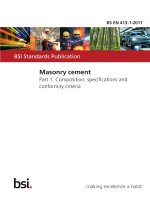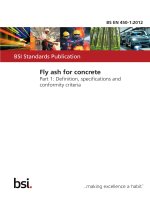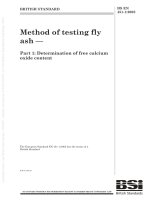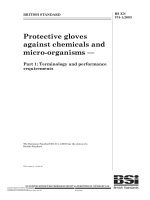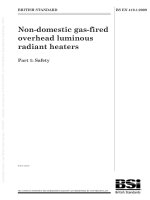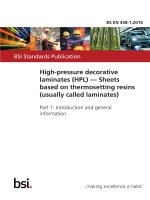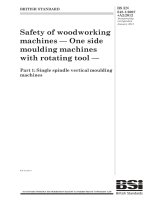Bsi bs en 61326 1 2013
Bạn đang xem bản rút gọn của tài liệu. Xem và tải ngay bản đầy đủ của tài liệu tại đây (1.2 MB, 26 trang )
BS EN 61326-1:2013
Incorporating
corrigendum October 2013
BS EN 61326-1:2013
BSI Standards Publication
Electrical equipment for
measurement, control
and laboratory use —
EMC requirements
Part 1: General requirements
BS EN 61326-1:2013
BRITISH STANDARD
National foreword
This British Standard is the UK implementation of EN 61326-1:2013. It is
identical to IEC 61326-1:2012. It supersedes BS EN 61326-1:2006, which will
be withdrawn on 14 August 2015.
The UK participation in its preparation was entrusted by Technical
Committee GEL/65, Measurement and control, to Subcommittee GEL/65/1,
System considerations.
A list of organizations represented on this subcommittee can be
obtained on request to its secretary.
This publication does not purport to include all the necessary provisions
of a contract. Users are responsible for its correct application.
© The British Standards Institution 2013.
Published by BSI Standards Limited 2013
ISBN 978 0 580 84607 6
ICS 25.040.40; 33.100.01
Compliance with a British Standard cannot confer immunity from
legal obligations.
This British Standard was published under the authority of the Standards
Policy and Strategy Committee on 28 February 2013.
Amendments/corrigenda issued since publication
Date
Text affected
31 October 2013
CEN Endorsement notice and Annex ZA corrected
EUROPEAN STANDARD
BS EN 61326-1:2013
EN 61326-1
NORME EUROPÉENNE
EUROPÄISCHE NORM
January 2013
ICS 17.220; 19.080; 25.040.40; 33.100
Supersedes EN 61326-1:2006
English version
Electrical equipment for measurement, control and laboratory use EMC requirements Part 1: General requirements
(IEC 61326-1:2012)
Matériel électrique de mesure, de
commande et de laboratoire Exigences relatives à la CEM Partie 1: Exigences générales
(CEI 61326-1:2012)
Elektrische Mess-, Steuer-, Regel- und
Laborgeräte EMV-Anforderungen Teil 1: Allgemeine Anforderungen
(IEC 61326-1:2012)
This European Standard was approved by CENELEC on 2012-08-14. CENELEC members are bound to comply
with the CEN/CENELEC Internal Regulations which stipulate the conditions for giving this European Standard
the status of a national standard without any alteration.
Up-to-date lists and bibliographical references concerning such national standards may be obtained on
application to the CEN-CENELEC Management Centre or to any CENELEC member.
This European Standard exists in three official versions (English, French, German). A version in any other
language made by translation under the responsibility of a CENELEC member into its own language and notified
to the CEN-CENELEC Management Centre has the same status as the official versions.
CENELEC members are the national electrotechnical committees of Austria, Belgium, Bulgaria, Croatia, Cyprus,
the Czech Republic, Denmark, Estonia, Finland, Former Yugoslav Republic of Macedonia, France, Germany,
Greece, Hungary, Iceland, Ireland, Italy, Latvia, Lithuania, Luxembourg, Malta, the Netherlands, Norway, Poland,
Portugal, Romania, Slovakia, Slovenia, Spain, Sweden, Switzerland, Turkey and the United Kingdom.
CENELEC
European Committee for Electrotechnical Standardization
Comité Européen de Normalisation Electrotechnique
Europäisches Komitee für Elektrotechnische Normung
Management Centre: Avenue Marnix 17, B - 1000 Brussels
© 2013 CENELEC -
All rights of exploitation in any form and by any means reserved worldwide for CENELEC members.
Ref. No. EN 61326-1:2013 E
BS EN 61326-1:2013
EN 61326-1:2013
EN 61326-1:2013
-2-
Foreword
Foreword
The text of document 65A/628/FDIS, future edition 2 of IEC 61326-1, prepared
The text of document 65A/628/FDIS, future edition 2 of IEC 61326-1, prepared
aspects", of IEC TC 65, "Industrial-process measurement, control and automation"
aspects", of IEC TC 65, "Industrial-process measurement, control and automation"
IEC-CENELEC parallel vote and approved by CENELEC as EN 61326-1:2013.
IEC-CENELEC parallel vote and approved by CENELEC as EN 61326-1:2013.
by SC 65A, "System
by SC 65A, "System
was submitted to the
was submitted to the
The following dates are fixed:
The following dates are fixed:
•
•
•
•
latest date by which the document has
latest date by which the document has
to be implemented at national level by
to be implemented at national level by
publication of an identical national
publication of an identical national
standard or by endorsement
standard or by endorsement
latest date by which the national
latest date by which the national
standards conflicting with the
standards conflicting with the
document have to be withdrawn
document have to be withdrawn
(dop)
(dop)
2013-07-11
2013-07-11
(dow)
(dow)
2015-08-14
2015-08-14
This document supersedes EN 61326-1:2006.
This document supersedes EN 61326-1:2006.
EN 61326-1:2013 includes the following significant technical changes with respect to EN 61326-1:2006:
EN 61326-1:2013 includes the following significant technical changes with respect to EN 61326-1:2006:
– the immunity test levels and performance criteria have been reviewed;
– the immunity test levels and performance criteria have been reviewed;
– requirements for portable test and measurement equipment have been clarified and amended;
– requirements for portable test and measurement equipment have been clarified and amended;
– the description of the electromagnetic environments has been improved.
– the description of the electromagnetic environments has been improved.
Attention is drawn to the possibility that some of the elements of this document may be the subject of
Attention is drawn to the possibility that some of the elements of this document may be the subject of
patent rights. CENELEC [and/or CEN] shall not be held responsible for identifying any or all such patent
patent rights. CENELEC [and/or CEN] shall not be held responsible for identifying any or all such patent
rights.
rights.
This document has been prepared under a mandate given to CENELEC by the European Commission
This document has been prepared under a mandate given to CENELEC by the European Commission
and the European Free Trade Association, and supports essential requirements of EU Directive(s).
and the European Free Trade Association, and supports essential requirements of EU Directive(s).
For the relationship with EU Directive(s) see informative Annex ZZ, which is an integral part of this
For the relationship with EU Directive(s) see informative Annex ZZ, which is an integral part of this
document.
document.
Endorsement
Endorsement notice
notice
The text of the International Standard IEC 61326-1:2012 was approved by CENELEC as a European
The text of the International Standard IEC 61326-1:2012 was approved by CENELEC as a European
Standard without any modification.
Standard without any modification.
In the official version, for Bibliography, the following notes have to be added for the standards indicated:
In the official version, for Bibliography, the following notes have to be added for the standards indicated:
IEC 60359
IEC 60359
NOTE Harmonized as EN 60359.
NOTE Harmonized as EN 60359.
IEC 61000-6-1:2005
IEC 61000-6-1:2005
NOTE Harmonized as EN 61000-6-1:2007 (not modified).
NOTE Harmonized as EN 61000-6-1:2007 (not modified).
IEC 61000-6-2:2005
IEC 61000-6-2:2005
NOTE Harmonized as EN 61000-6-2:2005 (not modified).
NOTE Harmonized as EN 61000-6-2:2005 (not modified).
IEC 61010 series
IEC 61010 series
NOTE Harmonized in EN 61010 series (not modified).
NOTE Harmonized in EN 61010 series (not modified).
IEC 61326-2 series
IEC 61326-2 series
NOTE Harmonized in EN 61326-2 series (not modified).
NOTE Harmonized in EN 61326-2 series (not modified).
IEC 61326-2-2
IEC 61326-2-2
NOTE Harmonized as EN 61326-2-2.
NOTE Harmonized as EN 61326-2-2.
-3-
BS EN 61326-1:2013
EN 61326-1:2013
Annex ZA
(normative)
Normative references to international publications
with their corresponding European publications
The following documents, in whole or in part, are normatively referenced in this document and are
indispensable for its application. For dated references, only the edition cited applies. For undated
references, the latest edition of the referenced document (including any amendments) applies.
NOTE
When an
an international
international publication
has been
been modified
modified by
by common
common modifications,
modifications, indicated
indicated by
by (mod),
(mod), the
NOTE When
publication has
the relevant
relevant EN/HD
EN/HD
applies.
applies.
Publication
IEC 60050
Year
Title
EN/HD
Series International Electrotechnical Vocabulary
EN 61000-3-2
2005
Electromagnetic compatibility (EMC) 2008
Part 3-2: Limits - Limits for harmonic current + A1
2009
emissions (equipment input current ≤ 16 A per + A2
phase)
2008
Electromagnetic compatibility (EMC) EN 61000-3-3
Part 3-3: Limits - Limitation of voltage
changes, voltage fluctuations and flicker in
public low-voltage supply systems, for
equipment with rated current ≤ 16 A per
phase and not subject to conditional
connection
2000
Electromagnetic compatibility (EMC) EN 61000-3-11
Part 3-11: Limits - Limitation of voltage
changes, voltage fluctuations and flicker in
public low-voltage supply systems Equipment with rated current ≤ 75 A and
subject to conditional connection
2011
Electromagnetic compatibility (EMC) EN 61000-3-12
Part 3-12: Limits - Limits for harmonic currents
produced by equipment connected to public
low-voltage systems with input current > 16 A
and ≤ 75 A per phase
Year
-
IEC 61000-4-2
2008
IEC 61000-4-3
+ A1
+ A2
2006
2007
2010
IEC 61000-4-4
+ corr. June
+ A1
2004
2007
2010
IEC 61000-4-5
+ corr. October
2005
2009
IEC 61000-3-2
+ A1
+ A2
IEC 61000-3-3
IEC 61000-3-11
IEC 61000-3-12
2006
2009
2009
2008
2000
2011
Electromagnetic compatibility (EMC) Part 4-2: Testing and measurement
techniques - Electrostatic discharge immunity
test
Electromagnetic compatibility (EMC) Part 4-3: Testing and measurement
techniques - Radiated, radio-frequency,
electromagnetic field immunity test
Electromagnetic compatibility (EMC) Part 4-4: Testing and measurement
techniques - Electrical fast transient/burst
immunity test
EN 61000-4-2
2009
EN 61000-4-3
+ A1
+ A2
2006
2008
2010
EN 61000-4-4
+ A1
2004
2010
Electromagnetic compatibility (EMC) Part 4-5: Testing and measurement
techniques - Surge immunity test
EN 61000-4-5
2006
BS EN 61326-1:2013
EN 61326-1:2013
Publication
Year
Title
EN/HD
Year
IEC 61000-4-6
2008
Electromagnetic compatibility (EMC) Part 4-6: Testing and measurement
techniques - Immunity to conducted
disturbances, induced by radio-frequency
fields
EN 61000-4-6
2009
IEC 61000-4-8
2009
Electromagnetic compatibility (EMC) EN 61000-4-8
Part 4-8: Testing and measurement
techniques - Power frequency magnetic field
immunity test
2010
IEC 61000-4-11
2004
Electromagnetic compatibility (EMC) EN 61000-4-11
Part 4-11: Testing and measurement
techniques - Voltage dips, short interruptions
and voltage variations immunity tests
2004
CISPR 11 (mod)
+ A1
2009
2010
Industrial, scientific and medical equipment - EN 55011
Radio-frequency disturbance characteristics - + A1
Limits and methods of measurement
2009
2010
BS EN 61326-1:2013
EN 61326-1:2013
Annex ZZ
(informative)
Coverage of Essential Requirements of EU Directives
This European Standard has been prepared under a mandate given to CENELEC by the European
Commission and the European Free Trade Association and within its scope the standard covers
protection requirements of Annex I, Article 1 of the EC Directive 2004/108/EC.
Compliance with this standard provides one means of conformity with the specified essential
requirements of the Directive[s] concerned.
NOTE
Other requirements and other EU Directives may be applicable to the products falling within the scope of
this standard.
BS EN 61326-1:2013
61326-1 © IEC:2012
CONTENTS
INTRODUCTION . .................................................................................................................................. 6
1
Scope . ............................................................................................................................................. 7
2
Normative references . .................................................................................................................. 8
3
Terms and definitions . .................................................................................................................. 9
4
General ......................................................................................................................................... 11
5
EMC test plan . ............................................................................................................................. 12
5.1
5.2
6
General . ............................................................................................................................. 12
Configuration of EUT during testing . .............................................................................. 12
5.2.1 General . ................................................................................................................ 12
5.2.2 Composition of EUT ............................................................................................. 12
5.2.3 Assembly of EUT . ................................................................................................ 12
5.2.4 I/O ports . ............................................................................................................... 12
5.2.5 Auxiliary equipment ............................................................................................. 12
5.2.6 Cabling and earthing (grounding) . ..................................................................... 12
5.3 Operation conditions of EUT during testing . .................................................................. 13
5.3.1 Operation modes . ................................................................................................ 13
5.3.2 Environmental conditions .................................................................................... 13
5.3.3 EUT software during test .................................................................................... 13
5.4 Specification of functional performance . ....................................................................... 13
5.5 Test description . ................................................................................................................ 13
Immunity requirements ............................................................................................................... 13
6.1
6.2
6.3
6.4
7
Conditions during the tests . ............................................................................................. 13
Immunity test requirements ............................................................................................. 13
Random aspects. ............................................................................................................... 16
Performance criteria . ........................................................................................................ 17
6.4.1 General . ................................................................................................................ 17
6.4.2 Performance criterion A . ..................................................................................... 17
6.4.3 Performance criterion B . ..................................................................................... 17
6.4.4 Performance criterion C . ..................................................................................... 17
Emission requirements ............................................................................................................... 17
7.1
7.2
Conditions during measurements ................................................................................... 17
Emission limits . ................................................................................................................. 18
8
Test results and test report . ....................................................................................................... 18
9
Instructions for use . .................................................................................................................... 18
Annex A (normative) Immunity test requirements for portable test and measurement
equipment powered by battery or from the circuit being measured . ........................................... 19
Bibliography ......................................................................................................................................... 20
Figure 1 – Examples of ports . .......................................................................................................... 11
Table 1 – Immunity test requirements for equipment intended to be used in a basic
electromagnetic environment . .......................................................................................................... 14
Table 2 – Immunity test requirements for equipment intended to be used in an
industrial electromagnetic environment . ......................................................................................... 15
BS EN 61326-1:2013
61326-1 © IEC:2012
Table 3 – Immunity test requirements for equipment intended to be used in a
controlled electromagnetic environment . ........................................................................................ 16
Table A.1 – Immunity test requirements for portable test and measurement equipment . ........ 19
BS EN 61326-1:2013
–6–
61326-1 © IEC:2012
INTRODUCTION
Instruments and equipment within the scope of this standard may often be geographically
widespread and hence operate under a wide range of environmental conditions.
The limitation of undesired electromagnetic emissions ensures that no other equipment,
installed nearby, is unduly influenced by the equipment under consideration. The limits are
more or less specified by, and therefore taken from, IEC and International Special Committee
on Radio Interference (CISPR) publications.
However, the equipment should function without undue degradation in an electromagnetic
environment typical for the locations where it is intended to be operated. In this respect the
standard specifies three different types of electromagnetic environment and the levels for
immunity. More detailed information about issues related to electromagnetic environments are
given in IEC 61000-2-5. Special risks, involving for example nearby or direct lightning strikes,
circuit-breaking, or exceptionally high electromagnetic radiation in close proximity, are not
covered.
Complex electric and/or electronic systems should require EMC planning in all phases of their
design and installation, taking into consideration the electromagnetic environment, any
special requirements, and the severity of failures.
This part of IEC 61326 specifies the EMC requirements that are generally applicable to all
equipment within its scope. For certain types of equipment, these requirements will be
supplemented or modified by the special requirements of one, or more than one, particular
part within IEC 61326-2 series. These should be read in conjunction with the IEC 61326-1
requirements.
BS EN 61326-1:2013
61326-1 © IEC:2012
–7–
ELECTRICAL EQUIPMENT FOR MEASUREMENT,
CONTROL AND LABORATORY USE –
EMC REQUIREMENTS –
Part 1: General requirements
1
Scope
This part of IEC 61326 specifies requirements for immunity and emissions regarding electromagnetic compatibility (EMC) for electrical equipment, operating from a supply or battery of
less than 1 000 V a.c. or 1 500 V d.c. or from the circuit being measured. Equipment intended
for professional, industrial-process, industrial-manufacturing and educational use is covered
by this part. It includes equipment and computing devices for
–
measurement and test;
–
control;
–
laboratory use;
–
accessories intended for use with the above (such as sample handling equipment),
intended to be used in industrial and non-industrial locations.
Computing devices and assemblies and similar equipment within the scope of Information
Technology Equipment (ITE) and complying with applicable ITE EMC standards may be used
in systems within the scope of this part of IEC 61326 without additional testing, if they are
suitable for the intended electromagnetic environment.
It is generally considered that this standard takes precedence over the corresponding generic
EMC standards.
The following equipment is covered by this standard.
a) Electrical measurement and test equipment
This is equipment which, by electrical means, measures, indicates or records one or more
electrical or non-electrical quantities, also non-measuring equipment such as signal
generators, measurement standards, power supplies and transducers.
b) Electrical control equipment
This is equipment which controls one or more output quantities to specific values, with
each value determined by manual settings, by local or remote programming, or by one or
more input variables. This includes Industrial Process Measurement and Control (IPMC)
equipment, which consists of devices such as:
–
process controllers and regulators;
–
programmable controllers;
–
power supply units for equipment and systems (centralized or dedicated);
–
analogue/digital indicators and recorders;
–
process instrumentation;
–
transducers, positioners, intelligent actuators, etc.
BS EN 61326-1:2013
–8–
61326-1 © IEC:2012
c) Electrical laboratory equipment
This is equipment which measures, indicates monitors or analyses substances, or is used
to prepare materials, and includes In Vitro Diagnostic (IVD) equipment. This equipment
may also be used in areas other than laboratories, for example self-test IVD equipment
may be used in the home.
Equipment within the scope of this standard might be operated in different electromagnetic
environments; depending on the electromagnetic environment different emission and immunity
test requirements are applicable.
This standard considers three types of electromagnetic environments:
•
basic electromagnetic environment;
•
industrial electromagnetic environment;
•
controlled electromagnetic environment.
Corresponding immunity test requirements are described in Clause 6.
In terms of emission requirements, equipment shall be classified in Class A or Class B
equipment, as per the requirements and procedure of CISPR 11. The corresponding emission
requirements are described in Clause 7.
2
Normative references
The following documents, in whole or in part, are normatively referenced in this document and
are indispensable for its application. For dated references, only the edition cited applies. For
undated references, the latest edition of the referenced document (including any
amendments) applies.
IEC 60050
(all
parts),
International
<>)
Electrotechnical
Vocabulary
(available
at
IEC 61000-3-2:2005, Electromagnetic compatibility (EMC) – Part 3-2: Limits – Limits for
harmonic current emissions (equipment input current ≤ 16 A per phase)
Amendment 1:2008
Amendment 2:2009
IEC 61000-3-3:2008, Electromagnetic compatibility (EMC) – Part 3-3: Limits – Limitation of
voltage changes, voltage fluctuations and flicker in public low-voltage supply systems, for
equipment with rated current ≤ 16 A per phase and not subject to conditional connection
IEC 61000-3-11:2000, Electromagnetic compatibility (EMC) – Part 3-11: Limits – Limitation of
voltage changes, voltage fluctuations and flicker in public low-voltage supply systems –
Equipment with rated current ≤75 A and subject to conditional connection
IEC 61000-3-12:2011, Electromagnetic compatibility (EMC) – Part 3-12: Limits – Limits for
harmonic currents produced by equipment connected to public low-voltage systems with input
current > 16 A and ≤ 75 A per phase
IEC 61000-4-2:2008, Electromagnetic compatibility (EMC) – Part 4-2: Testing and measurement techniques – Electrostatic discharge immunity test
IEC 61000-4-3:2006, Electromagnetic compatibility (EMC) – Part 4-3: Testing and measurement techniques – Radiated, radio-frequency, electromagnetic field immunity test
Amendment 1:2007
Amendment 2:2010
BS EN 61326-1:2013
61326-1 © IEC:2012
–9–
IEC 61000-4-4:2004, Electromagnetic compatibility (EMC) – Part 4-4: Testing and measurement techniques – Electrical fast transient/burst immunity test
Amendment 1:2010
IEC 61000-4-5:2005, Electromagnetic compatibility (EMC) – Part 4-5: Testing and measurement techniques – Surge immunity test
IEC 61000-4-6:2008, Electromagnetic compatibility (EMC) – Part 4-6: Testing and measurement techniques – Immunity to conducted disturbances, induced by radio-frequency fields
IEC 61000-4-8:2009, Electromagnetic compatibility (EMC) – Part 4-8: Testing and measurement techniques – Power frequency magnetic field immunity test
IEC 61000-4-11:2004, Electromagnetic compatibility (EMC) – Part 4-11: Testing and measurement techniques – Voltage dips, short interruptions and voltage variations immunity tests
CISPR 11:2009, Industrial, scientific and medical equipment – Radio-frequency disturbance
characteristics – Limits and methods of measurement
Amendment 1:2010
3
Terms and definitions
For the purposes of this document, the terms and definitions given in IEC 60050-161 as well
as the following apply.
3.1
basic electromagnetic environment
environment existing at locations characterized by being supplied directly at low voltage from
the public mains network
EXAMPLES
– residential properties, for example houses, apartments;
– retail outlets, for example shops, supermarkets;
– business premises, for example offices, banks;
– areas of public entertainment, for example cinemas, public bars, dance halls;
– outdoor locations, for example petrol stations, car parks, amusement and sports centres;
– light-industrial locations, for example workshops, laboratories, service centres.
3.2
class A equipment
equipment suitable for use in all establishments other than domestic and those directly
connected to a low voltage power supply network which supplies buildings used for domestic
purposes
[SOURCE: derived from CISPR 11:2009, 5.3]
3.3
class B equipment
equipment suitable for use in domestic establishments and in establishments directly
connected to a low voltage power supply network which supplies buildings used for domestic
purposes
[SOURCE: derived from CISPR 11:2009, 5.3]
BS EN 61326-1:2013
– 10 –
61326-1 © IEC:2012
3.4
controlled electromagnetic environment
environment usually characterized by recognition and control of EMC threats by users of the
equipment or by design of the installation
3.5
d.c. distribution network
local d.c. electricity supply network in the infrastructure of a certain site or building intended
for connection to the d.c. power port of any type of equipment
3.6
enclosure port
physical boundary of equipment through which electromagnetic fields may radiate or impinge
3.7
functional performance
operational performance characteristics specified by the manufacturer of the equipment,
defining the ability of equipment to achieve the intended functions
3.8
industrial electromagnetic environment
environment existing at locations characterized by a separate power network, in most cases
supplied from a high- or medium-voltage transformer, dedicated for the supply of installations
feeding manufacturing or similar plants with one or more of the following conditions:
–
frequent switching of heavy inductive or capacitive loads;
–
high currents and associated magnetic fields;
–
presence of Industrial, Scientific and Medical (ISM) equipment (for example, welding
machines)
3.9
laboratory
test and measurement area
area that is specifically used for analysis, testing and servicing and where equipment is
operated by trained personnel
3.10
long-distance lines
lines within a building which are longer than 30 m, or which leave the building (including lines
of outdoor installations)
3.11
port
any particular interface of the specific device or system with the external electromagnetic
environment
EXAMPLE
See Figure 1 for an example of Equipment Under Test (EUT).
Note 1 to entry: I/O ports are input, output or bi-directional, measurement, control, or data ports.
Note 2 to entry: Within this document, ports intended to be connected with earth potential for functional reasons
(functional earth ports) are considered as I/O ports
Note 3 to entry: Within this document the protective earth port (if any) is considered as part of the power port.
61326-1 © IEC:2012
– 11 –
Enclosure port
AC power port
EUT
DC power port
I/O port
IEC
1277/12
Figure 1 – Examples of ports
3.12
portable (measuring) instrument
measuring instrument designed to be easily carried by hand and to be connected and
disconnected by the user
[SOURCE: IEC 60050-300:2001, 312-02-18]
3.13
type test
conformity test made on one or more items representative of the production
[SOURCE: IEC 60050-151:2001, 151-16-16]
4
General
Equipment and systems within the scope of this standard can be subjected to various kinds of
electromagnetic disturbances, conducted by power, measurement or control lines, or radiated
from the environment. The types and levels of disturbances depend on the particular
conditions in which the systems, subsystems or equipment are installed and operated.
Equipment and individual devices of a system within the scope of this standard can also be a
source of electromagnetic disturbances over a wide frequency range. These disturbances can
be conducted through power and signal lines, or be directly radiated, and can affect the
performance of other equipment, or influence the external electromagnetic environment.
For emissions, the objective of the requirements given in this standard is to ensure that the
disturbances generated by the equipment and systems, when operated normally, do not
exceed a level which could prevent other systems from operating as intended. The emission
limits are considered in 7.2.
The manufacturer shall give information that emissions, which exceed the levels required by
this standard, can occur when equipment is connected to a test object.
NOTE 1 Higher immunity levels, different number of tests and different performance criteria than those specified
can be necessary for particular applications (for example, when reliable operation of the equipment is essential for
safety) or when the equipment is intended for use in harsher electromagnetic environments.
NOTE 2 In special cases, for example when highly susceptible equipment is being used in close proximity,
additional mitigation measures may have to be employed to reduce the influencing electromagnetic emission
further below the specified limits.
NOTE 3 The manufacturer may elect to perform all tests either on a single EUT or more than one. The testing
sequence is optional.
BS EN 61326-1:2013
– 12 –
5
61326-1 © IEC:2012
EMC test plan
5.1
General
An EMC test plan shall be established prior to testing. It shall contain, as a minimum, the
elements given in 5.2 to 5.5.
It may be determined from consideration of the electrical characteristics and usage of a
particular item of equipment that some tests are inappropriate and therefore unnecessary. In
such cases, the decision not to test shall be recorded in the EMC test plan.
5.2
5.2.1
Configuration of EUT during testing
General
Measurement, control and laboratory equipment often consists of systems with no fixed
configuration. The kind, number and installation of different subassemblies within the equipment may vary from system to system. Thus it is reasonable, and also recommended, not to
test every possible arrangement.
To realistically simulate EMC conditions (related both to emission and immunity), the
equipment assembly shall represent a typical installation as specified by the manufacturer.
Such tests shall be carried out as type tests under normal conditions as specified by the
manufacturer.
5.2.2
Composition of EUT
All devices, racks, modules, boards, etc. significant to EMC and belonging to the EUT shall be
documented. If relevant, the software version shall be documented .
5.2.3
Assembly of EUT
If an EUT has a variety of internal and external configurations, the type tests shall be made
with one or more typical configurations that represent normal use. All types of modules shall
be tested at least once. The rationale for this selection shall be documented in the EMC test
plan.
5.2.4
I/O ports
Where there are multiple I/O ports, which are all of the same type, connecting a cable to just
one of those ports is sufficient, provided that it can be shown that the additional cables would
not affect the results significantly.
If not otherwise specified in more specific parts of the IEC 61326 series, electrostatic
discharges shall not be applied to inner pins of plug-in ports or cable connectors (but to
connected connectors accessible during the intended use of the EUT).
5.2.5
Auxiliary equipment
When a variety of devices is provided for use with the EUT, at least one of each type of
device shall be selected to simulate actual operating conditions. Auxiliary devices may be
simulated.
5.2.6
Cabling and earthing (grounding)
The cables and earth (ground) shall be connected to the EUT in accordance with the
manufacturer's specifications. There shall be no additional earth connections.
BS EN 61326-1:2013
61326-1 © IEC:2012
5.3
– 13 –
Operation conditions of EUT during testing
5.3.1
Operation modes
A selection of representative operation modes shall be made, taking into account that not all
functions, but only the most typical functions of the electronic equipment can be tested. The
estimated worst-case operating modes for normal application shall be selected.
5.3.2
Environmental conditions
The tests shall be carried out within the manufacturer’s specified environmental operating
range (for example, ambient temperature, humidity, atmospheric pressure), and within the
rated ranges of supply voltage and frequency.
5.3.3
EUT software during test
The software used for simulating the different modes of operation shall be documented. This
software shall represent the estimated worst-case operating mode for normal application.
5.4
Specification of functional performance
For immunity tests, functional performance for each operating mode and test shall be
specified; where possible, as quantitative values.
5.5
Test description
Each test to be applied shall be specified in the EMC test plan. The description of the tests,
the test methods, the characteristics of the tests, and the test set-ups are given in the basic
standards, which are referred to in 6.2 and 7.2. Additional information needed for the practical
implementation of the tests is given in this standard. The contents of standards need not be
reproduced in the test plan. In some cases, the EMC test plan shall specify the application in
detail.
NOTE Not all known disturbance phenomena have been specified for testing purposes in this standard, but only
those which are considered as most critical.
6
6.1
Immunity requirements
Conditions during the tests
The configuration and modes of operation during the tests shall be precisely noted in the test
report.
Tests shall be applied to the relevant ports in accordance with Tables 1 or 2 or 3, as
applicable.
The tests shall be conducted in accordance with the basic standards. The tests shall be
carried out one at a time. If additional measures not described in the basic standards are
required, these measures and their rationale shall be documented in the test report.
6.2
Immunity test requirements
Table 1 gives the immunity requirements for equipment intended to be used in a basic
electromagnetic environment.
Table 2 gives the immunity requirements for equipment intended to be used in an industrial
electromagnetic environment.
BS EN 61326-1:2013
– 14 –
61326-1 © IEC:2012
Table 3 gives the immunity requirements for equipment intended to be used in a controlled
electromagnetic environment.
The performance criteria A, B, and C that are mentioned in the following tables are described
in 6.4.
Table 1 – Immunity test requirements for equipment
intended to be used in a basic electromagnetic environment
Port
Enclosure
AC power
Phenomenon
Basic
standard
g
(including protective
earth)
IEC 61000-4-2
4 kV contact discharge
8 kV air discharge
B
B
Electromagnetic field
IEC 61000-4-3
3 V/m (80 MHz to 1 GHz)
3 V/m (1,4 GHz to 2 GHz)
1 V/m (2,0 GHz to 2,7 GHz)
A
A
A
Power frequency magnetic field
IEC 61000-4-8
3 A/m (50 Hz, 60 Hz) f
A
Voltage dip
IEC 61000-4-11
0 % during half cycle
0 % during 1 cycle
e
70 % during 25/30 cycles
B
B
C
Short interruptions
IEC 61000-4-11
0 % during 250/300 cycles
C
Burst
IEC 61000-4-4
1 kV (5/50 ns, 5 kHz)
B
Surge
IEC 61000-4-5
0,5 kV a) /1 kV b)
B
Conducted RF
IEC 61000-4-6
3 V (150 kHz to 80 MHz)
A
Burst
IEC 61000-4-4
1 kV(5/50 ns, 5 kHz)
B
Surge
IEC 61000-4-5
0,5 kV a /1 kV b
B
Conducted RF
IEC 61000-4-6
3 V (150 kHz to 80 MHz)
IEC 61000-4-4
0,5 kV d (5/50 ns, 5 kHz)
B
IEC 61000-4-5
1 kV b,
B
Conducted RF
IEC 61000-4-6
3 V d (150 kHz to 80 MHz)
Burst
IEC 61000-4-4
1 kV(5/50 ns, 5 kHz)
B
Surge
IEC 61000-4-5
0,5 kV a /1 kV b
B
Conducted RF
IEC 61000-4-6
3 V (150 kHz to 80 MHz)
A
Burst
I/O signal/control
(including functional
Surge
earth )
I/O signal/control
connected directly
to mains supply
a
Line to line.
b
Line to ground.
Performance
criterion
Electrostatic discharge (ESD)
(including protective
earth)
DC power d,
Test value
e
c
A
A
c
Only in the case of long-distance lines (see 3.10).
d
Only in the case of lines >3 m.
e
For example “25/30 cycles" means "25 cycles for 50 Hz test" or "30 cycles for 60 Hz test”.
f
Only to magnetically sensitive equipment. CRT display interference is allowed above 1 A/m.
g
DC connections between parts of equipment/system which are not connected to a d.c. distribution network are
treated as I/O signal/control ports.
BS EN 61326-1:2013
61326-1 © IEC:2012
– 15 –
Table 2 – Immunity test requirements for equipment intended
to be used in an industrial electromagnetic environment
Port
Enclosure
AC power
Phenomenon
Basic standard
(including
protective earth)
IEC 61000-4-2
4 kV contact discharge
8 kV air discharge
B
B
Electromagnetic field
IEC 61000-4-3
10 V/m (80 MHz to 1 GHz)
3 V/m (1,4 GHz to 2 GHz)
1 V/m (2,0 GHz to 2,7 GHz)
A
A
A
Power frequency magnetic field
IEC 61000-4-8
30 A/m (50 Hz, 60 Hz) e
A
Voltage dip
IEC 61000-4-11
0 % during 1 cycle
g
40 % during 10/12 cycles
g
70 % during 25/30 cycles
B
C
C
Short interruptions
IEC 61000-4-11
0 % during 250/300
Burst
IEC 61000-4-4
2 kV(5/50 ns, 5 kHz)
Surge
IEC 61000-4-5
1 kV a /2 kV b
Conducted RF
IEC 61000-4-6
3 V f (150 kHz to 80 MHz)
Burst
IEC 61000-4-4
2 kV (5/50 ns, 5 kHz)
a
g
cycles
B
IEC 61000-4-5
1 kV /2 kV
IEC 61000-4-6
3 V f (150 kHz to 80 MHz)
Burst
Surge
Conducted RF
IEC 61000-4-5
1 kV (5/50 ns, 5 kHz)
1 kV
3V
IEC 61000-4-4
2 kV (5/50 ns, 5 kHz)
IEC 61000-4-6
d
a
(150 kHz to 80 MHz)
1 kV /2 kV
A
B
B
IEC 61000-4-6
IEC 61000-4-5
B
b, c
d, f
A
B
b
Conducted RF
IEC 61000-4-4
C
B
Surge
Burst
I/O signal/ control
(including functional
Surge
earth)
Conducted RF
I/O signal/ control
connected directly
to mains supply
Performance
criterion
Electrostatic discharge (ESD)
(including
protective earth)
DC power f
Test value
b
f
3 V (150 kHz to 80 MHz)
A
B
B
A
a
Line to line.
b
Line to ground.
c
Only in the case of long-distance lines (see 3.10).
d
Only in the case of lines > 3 m.
e
Only to magnetically sensitive equipment. CRT display interference is allowed above 1 A/m.
f
DC connections between parts of equipment/system which are not connected to a d.c. distribution network are
treated as I/O signal/control ports.
g
For example “25/30 cycles" means "25 cycles for 50 Hz test" or "30 cycles for 60 Hz test”.
BS EN 61326-1:2013
– 16 –
61326-1 © IEC:2012
Table 3 – Immunity test requirements for equipment intended
to be used in a controlled electromagnetic environment
Port
Enclosure
Phenomenon
Basic standard
Test value
Performan
ce
criterion
Electrostatic discharge (ESD)
IEC 61000-4-2
4 kV contact discharge
8 kV air discharge
B
B
Electromagnetic field
IEC 61000-4-3
1 V/m (80 MHz to 1 GHz)
1 V/m (1,4 GHz to 2 GHz)
1 V/m (2,0 GHz to 2,7 GHz)
A
A
A
AC power
Voltage dip
IEC 61000-4-11
0 % during half cycle
B
(including
protective earth)
Burst
IEC 61000-4-4
1 kV (5/50 ns, 5 kHz)
B
DC power
c, d
(including
protective earth)
I/O signal/ control
(including
functional earth)
b
Surge
IEC 61000-4-5
0,5 kV /1 kV
Conducted RF
IEC 61000-4-6
1 V (150 kHz to 80 MHz)
A
Burst
IEC 61000-4-4
1 kV (5/50 ns, 5 kHz)
B
Surge
IEC 61000-4-5
Not required
-
Conducted RF
IEC 61000-4-6
1 V (150 kHz to 80 MHz)
A
c
B
Burst
IEC 61000-4-4
0,5 kV (5/50 ns, 5 kHz)
B
Surge
IEC 61000-4-5
Not required
-
Conducted RF
a
a
IEC 61000-4-6
c
1 V (150 kHz to 80 MHz)
A
Line to line.
b
Line to ground.
c
Only in the case of lines >3 m.
d
DC connections between parts of equipment/system which are not connected to a d.c. distribution network are
treated as I/O signal/control ports.
The manufacturer shall state that equipment fulfilling the requirements in Table 3 is designed
to operate in a controlled electromagnetic environment, i.e. where RF transmitters such as
mobile telephones may not be used in close proximity.
NOTE In general, analysis, test and service laboratories have controlled EM environments, and personnel in
these areas are usually trained to be able to interpret results. Such environments normally contain equipment
which requires protection by devices like Uninterruptible Power Supplies (UPS), filters, or surge suppressers.
Hence, the test values shown in Table 3 are relaxed from those in Table 1.
6.3
Random aspects
The duration of each test and/or the number of tests shall be sufficient to ensure that the
performance criterion is met consistently. Due care shall be taken to avoid a false test pass
due to random effects (for example, due to a timing relationship between the test stimulus and
the operation of the EUT).
NOTE This is of particular concern for EUTs with functionality that can be defined or controlled by software or
firmware.
For instance, in the case of electrostatic discharge testing of a digital device, the EUT should
be exposed to at least 10 discharges at each polarity, test point and test level to exclude
random effects. In case of burst testing, it may be advisable to extend the testing time to more
than 1 min.
BS EN 61326-1:2013
61326-1 © IEC:2012
6.4
– 17 –
Performance criteria
6.4.1
General
The general principles (performance criteria) for the evaluation of the immunity test results
are the following.
6.4.2
Performance criterion A
The equipment shall continue to operate as intended during and after the test. No degradation
of performance or loss of function is allowed below a performance level specified by the
manufacturer, when the equipment is used as intended. The performance level may be
replaced by a permissible loss of performance. If the minimum performance level or the
permissible performance loss is not specified by the manufacturer, either of these may be
derived from the product description and documentation and what the user may reasonably
expect from the equipment if used as intended.
6.4.3
Performance criterion B
The equipment shall continue to operate as intended after the test. No degradation of
performance or loss of function is allowed below a performance level specified by the
manufacturer, when the equipment is used as intended. The performance level may be
replaced by a permissible loss of performance. During the test, degradation of performance is
however allowed. No change of actual operating state or stored data is allowed. If the
minimum performance level or the permissible performance loss is not specified by the
manufacturer, either of these may be derived from the product description and documentation
and what the user may reasonably expect from the equipment if used as intended.
EXAMPLE 1 A data transfer is controlled/checked by parity check or by other means. In the case of
malfunctioning, such as caused by a lightning strike, the data transfer will be repeated automatically. The reduced
data transfer rate at this time is acceptable.
EXAMPLE 2
During testing, an analogue function value may deviate. After the test, the deviation vanishes.
EXAMPLE 3 In the case of a monitor used only for man-machine monitoring, it is acceptable that some
degradation takes place for a short time, such as flashes during the burst application.
EXAMPLE 4
6.4.4
An intended change of the operating state is allowed if self-recoverable.
Performance criterion C
Temporary loss of function is allowed, provided the function is self-recoverable or can be
restored by the operation of the controls.
EXAMPLE 1 In the case of an interruption in the mains longer than the specified buffer time, the power supply
unit of the equipment is switched off. The switch-on may be automatic or carried out by the operator.
EXAMPLE 2 After a programme interruption caused by a disturbance, the processor functions of the equipment
stops at a defined position and is not left in a "crashed state". The operator's decision prompts may be necessary.
EXAMPLE 3
operator.
7
7.1
The test results in an opening of an over-current protection device that is replaced or reset by the
Emission requirements
Conditions during measurements
The measurements shall be made in the operating mode in accordance with the EMC test
plan (see Clause 5).
The description of the tests, the test methods, and the test set-ups are given in the reference
standards as stated in 7.2. The contents of the reference standards are not reproduced here;
however, modifications or additional information needed for the practical implementation of
application of the tests may be given in the different parts of the IEC 61326 series.
BS EN 61326-1:2013
– 18 –
7.2
61326-1 © IEC:2012
Emission limits
The equipment shall be classified and respective information shall be provided per the
applicable group and class as specified within CISPR 11:2009, Clause 5. Equipment
classification and choice of respective limits shall be determined after taking into account the
intended environment and emission requirement in the areas of use.
For Class A equipment, the limits, the measuring methods and the provisions given in
CISPR 11 apply.
For Class B equipment, the limits, the measuring methods and the provisions given in
CISPR 11, IEC 61000-3-2 (or IEC 61000-3-12) and IEC 61000-3-3 (or IEC 61000-3-11) apply.
For equipment using frequencies in the ISM bands, see CISPR 11.
8
Test results and test report
The test results shall be documented in a comprehensive test report with sufficient detail to
provide for test repeatability.
The test report shall contain the following minimum information:
–
EUT description;
–
EMC test plan;
–
test requirements, i.e. which type of electromagnetic environment is considered;
–
performance criteria;
–
test data and results;
–
if applicable,
performance;
–
test equipment and test set-up.
9
Instructions for use
characteristics
of
equipment
operation
deviation
from
functional
The manufacturer shall indicate the electromagnetic environment for which the EUT is
intended to be used.
If the manufacturer has specified a minimum performance level or any permissible
performance loss (as allowed in 6.4), valid under the electromagnetic immunity conditions
(see 6.2), then the related performance level shall be described in the instructions for use.
BS EN 61326-1:2013
61326-1 © IEC:2012
– 19 –
Annex A
(normative)
Immunity test requirements for portable test and measurement
equipment powered by battery or from the circuit being measured
Equipment covered within this Annex is portable test and measurement equipment that is
powered by battery or from the circuit being measured. Equipment that can be operated while
charging is excluded from this Annex.
NOTE 1 Test and measurement instruments within the scope of this annex can be used in a wide range of
locations, but by personnel capable of interpreting the results obtained. If these instruments are connected to a
mains supply, it is normally only by their test or measurement leads and only for a short duration of the test.
Hence, the number of electromagnetic phenomena shown in Table A.1 is reduced in relation to Table 1.
NOTE 2 Examples for equipment included in the scope of this annex but not limited to, are: equipment covered by
the scope of IEC 61326-2-2, digital multi-meters, stand alone current clamps, laboratory equipment, programmers,
on-site calibration units. Such equipment is intended to be operated by skilled personal and for a short duration of
measuring time only.
NOTE 3 Examples for equipment excluded from the scope of this annex are: monitoring equipment, control
equipment, energy meters, power meters, power analyzers, power quality instruments, oscilloscopes. Such
equipment is typically operated over a longer duration of measuring time.
NOTE 4 If RF transmitters are used in close proximity, they may disturb equipment within the scope of this
standard.
Table A.1 – Immunity test requirements for portable test and measurement equipment
Port
Enclosure
Phenomenon
Basic
standard
Test value
Performance
criterion
Electrostatic discharge (ESD)
IEC 61000-4-2
4 kV contact discharge
8 kV air discharge
B
B
Electromagnetic field
IEC 61000-4-3
3 V/m (80 MHz to 1 GHz)
3 V/m (1,4 GHz to 2 GHz)
1 V/m (2,0 GHz to 2,7 GHz)
A
A
A
IEC 61000-4-8
3 A/m at 50 Hz, 60 Hz
Power-frequency magnetic field
a
b
A
a
Only to magnetically sensitive equipment. CRT display interference is allowed above 1 A/m.
b
The test shall be carried out at the frequencies appropriate to the power supply frequency. Equipment
intended for use in areas supplied only at one of these frequencies need only be tested at that frequency
A battery charger used by the products within the scope of this Annex shall be tested
according to the requirements given in one of the Tables 1, 2 or 3 depending on the intended
electromagnetic environment.
BS EN 61326-1:2013
– 20 –
61326-1 © IEC:2012
Bibliography
IEC 60359, Electrical and electronic equipment – Expression of performance
IEC 60488-1:2004, Higher performance protocol for the standard digital interface for
programmable instrumentation – Part 1: General
IEC 61000-2-5, Electromagnetic compatibility (EMC) – Part 2-5: Environment – Description
and classification of electromagnetic environments
IEC 61000-6-1:2005, Electromagnetic compatibility (EMC) – Part 6-1: Generic standards –
Immunity for residential, commercial and light-industrial environments
IEC 61000-6-2:2005, Electromagnetic compatibility (EMC) – Part 6-2: Generic standards –
Immunity for industrial environments
IEC 61010 (all parts), Safety requirements for electrical equipment for measurement, control,
and laboratory use
IEC 61326-2 (all parts), Electrical equipment for measurement, control and laboratory use –
EMC requirements
IEC 61326-2-2, Electrical equipment for measurement, control and laboratory use – EMC
requirements – Part 2-2: Particular requirements – Test configurations, operational conditions
and performance criteria for portable test, measuring and monitoring equipment used in lowvoltage distribution systems
IEEE 1284:2000, IEEE standard signalling method for a bi-directional parallel peripheral
interface for personal computers
TIA/EIA-232-F, Interface between data terminal equipment and data circuit-terminating
equipment employing serial binary data interchange
____________
This page deliberately left blank
